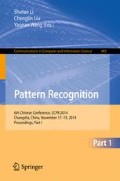Abstract
In the state-of-the-art saliency detection methods based on contrast priors, little attention is paid on the region smoothness constraints. The paper proposes a two-stage saliency detection method in which a smoothness prior is explicitly involved in a continuous Conditional Random Field (CRF). In stage one, we construct a continuous CRF based on the sparse codes of perceptual features on all locations, and minimize the energy of CRF to obtain discrimination maps. In stage two, we train a discriminative machine and learn the saliency maps from discrimination maps, aiming to take the human attention priors into consideration. Our experiments on MSRA-1000 show that the new method is effective against the state-of-the-art methods.
Access this chapter
Tax calculation will be finalised at checkout
Purchases are for personal use only
Preview
Unable to display preview. Download preview PDF.
References
Itti, L., Koch, C., Niebur, E.: A model of saliency-based visual attention for rapid scene analysis. IEEE Trans. PAMI 20(11), 1254–1259 (1998)
Bruce, N., Tsotsos, J.: Saliency based on information maximization. In: NIPS, vol. 18, p. 155 (2005)
Hou, X., Zhang, L.: Dynamic visual attention: Searching for coding length increments. In: NIPS, vol. 5, p. 7 (2008)
Zhang, J., Sclaroff, S.: Saliency detection: A boolean map approach. In: ICCV (2013)
Li, X., Li, Y., Shen, C., et al.: Contextual Hypergraph Modeling for salient object detection. In: ICCV (2013)
Gao, D., Mahadevan, V., Vasconcelos, N.: The discrimininant center-surround hypothesis for bottom-up saliency. In: NIPS (2007)
Feng, J., Wei, Y., Tao, L., et al.: Salient object detection by composition. In: ICCV (2011)
Klein, D., Frintrop, S.: Center-surround diverfence of feature statistics for salient object detection. In: ICCV (2011)
Chang, K., Liu, T., Chen, H., et al.: Fusing generic objectness and visual saliency for salient object detection. In: ICCV (2011)
Wei, Y., Wen, F., Zhu, W., Sun, J.: Geodesic saliency using background priors. In: Fitzgibbon, A., Lazebnik, S., Perona, P., Sato, Y., Schmid, C. (eds.) ECCV 2012, Part III. LNCS, vol. 7574, pp. 29–42. Springer, Heidelberg (2012)
Perazzi, F., Krahenbuhl, P., Ferrari, Y., et al.: Saliency filters: Contrast based filtering for salient region detection. In: CVPR (2012)
Shen, X., Wu, Y.: A unified approach to salient object detection via low rank matrix recovery. In: CVPR (2012)
Yang, J., Yang, M.: Top-down visual saliency via joint CRF and dictionary learning. In: CVPR (2012)
Taylor, C.: Towards Fast and Accurate Segmentation. In: CVPR (2013)
Vicente, S., Kolmogorov, V., Rother, C.: Joint optimization of segmentation and appearance models. In: ICCV (2009)
Rother, C., Kolmogorov, V., Blake, A.: Grabcut: interactive foreground extraction using iterated graph cuts. In: SIGGRAPH (2004)
Qin, T., Liu, T., Zhang, X., et al.: Global ranking using continuous conditional random fields. In: NIPS (2008)
Ren, X., Bo, L.: Discriminatively trained sparse code gradients for contour detection. In: NIPS (2012)
Achanta, R., Smith, K., et al.: Frequency-tuned salient region detection. In: CVPR (2009)
Golub, G., Van Loan, C.: Matrix Computations. John Hopkins Press (1996)
Author information
Authors and Affiliations
Editor information
Editors and Affiliations
Rights and permissions
Copyright information
© 2014 Springer-Verlag Berlin Heidelberg
About this paper
Cite this paper
Zhao, Q., Li, W., Wang, F., Yin, B. (2014). Two-Stage Saliency Detection Based on Continuous CRF and Sparse Coding. In: Li, S., Liu, C., Wang, Y. (eds) Pattern Recognition. CCPR 2014. Communications in Computer and Information Science, vol 483. Springer, Berlin, Heidelberg. https://doi.org/10.1007/978-3-662-45646-0_47
Download citation
DOI: https://doi.org/10.1007/978-3-662-45646-0_47
Publisher Name: Springer, Berlin, Heidelberg
Print ISBN: 978-3-662-45645-3
Online ISBN: 978-3-662-45646-0
eBook Packages: Computer ScienceComputer Science (R0)

